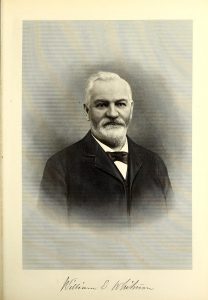Ancestors of William P. Whitman of Brockton, MA
WILLIAM P. WHITMAN, president and treasurer of the well-known shoe manufacturing concern of the Whitman & Keith Company, of Brockton, and one of that city’s successful and progressive business men, as was his father before him, is a descendant of distinguished and historic New England ancestry. Mr. Whitman is a direct descendant of John Alden and Priscilla Mullins, of the “Mayflower,” 1620; of Rev. James Keith, the first ordained minister of Bridgewater; and of John Whitman, who settled in Weymouth, Mass., as early as 1638, from whom descended many persons eminent in professional life and otherwise, among them Dr. Marcus Whitman, who saved the vast territory of Oregon to the United States; Hon. Ezekiel Whitman, for many years chief justice of the Superior and Supreme courts of the State of Maine; and Hon. William E. Russell, twice governor of Massachusetts.




